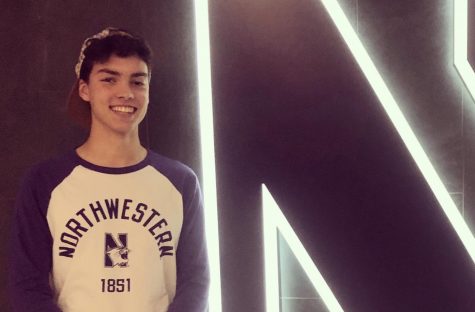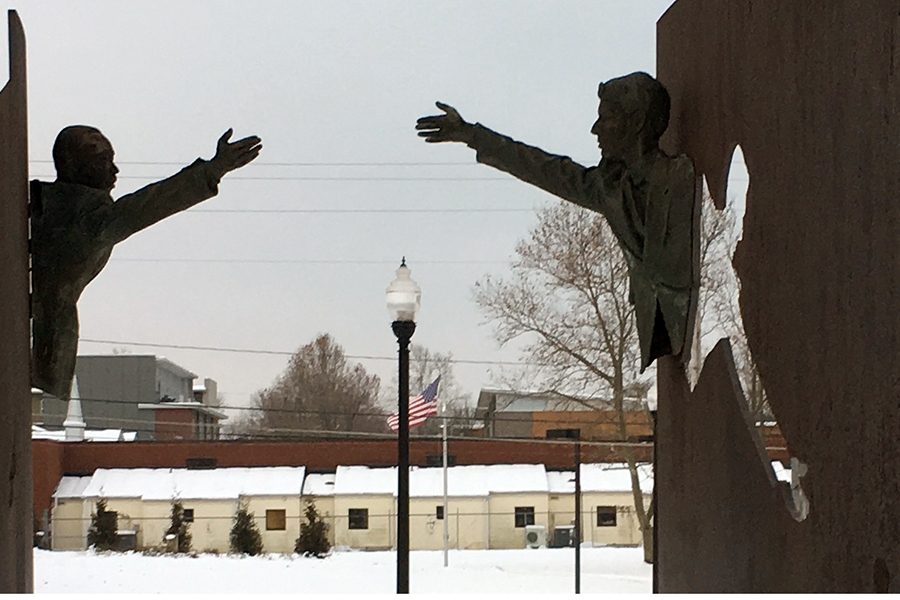Memorial honors of legacy of both King, Kennedy
Site adds special meaning to Jan. 21 federal holiday
A memorial to Dr. Martin Luther King Jr. and Sen. Robert F. Kennedy stands at the corner of 17th and Broadway streets on the near Northside.
After recently celebrating and remembering the life of Dr. Martin Luther King Jr. as a nation, America has once again been reminded of the scope and significance of the much needed change that he brought about. Dr. King has been recognized and immortalized in monuments and museums throughout the country; one such memorial that has gained national attention resides right in the heart of Indianapolis: The Landmark for Peace Memorial.
Located on 17th and Broadway, this commemorative sculpture is dedicated to Dr. King and Senator Bobby Kennedy (the brother of President John F. Kennedy), who was assassinated only a few months after Dr. King. Senator Kennedy was on a plane to Indianapolis when Dr. King was killed, and was informed of his death upon landing. After hearing that riots had broken out across the nation, he decided to stand up in front of a crowd that had gathered on 17th and Broadway.
He then gave an impromptu, heartfelt speech that has come to be recognized as one of America’s greatest speeches.
Ms. Baisinger, one of the teachers in the social studies department, has studied the civil rights movement and attests to the importance of what Bobby Kennedy did that day. “Having a member of the executive branch of the U.S. government, the president’s brother, and a white male, stand up and champion the same values that you see in the civil rights movement was unheard of. It gave many of the people who listened that day a hope that they did not previously have,” she said.
By encouraging all people to join together in prayer and unity for the cause that King gave his life for, he succeeded in sparking hope for many people who had just lost their leader. “What we need in the United States is not division; what we need in the United States is not hatred; what we need in the United States is not violence or lawlessness; but love and wisdom, and compassion toward one another,” said Kennedy.
Over 50 years later, his words are still remembered as a reminder of what is most important during times of tribulation.
Dr. Tom Greer, a familiar face around the school campus for years, was a sophomore in college when the news broke nationwide that King had been killed. “I recall sitting at my desk studying when I heard about Dr. King,” he said. “It was late in the night, and I recall thinking back to my high school years and the things that I had heard and remembered about him.”
Greer’s theology teacher in high school had traveled to march in Selma with King, and so he was able to hear first-hand about the events that transpired during the civil rights movement. Thus, he was particularly moved when the news of both King and later Kennedy broke out. “Bobby Kennedy became for me a man who could make peace with words and a kind and gentle heart. To this day when I hear those words from that recording, I shed a tear,” he said.
Being a student in college during such a trying time for the country was quite the experience, and Greer attests that this period in American history taught him an important lesson: “Always be prepared, for you never know when it might be your turn to speak out for injustice.”
Almost 30 years after those events in 1968, Indiana Democratic politico Mr. Larry Conrad approached the Simon family, owners of the Simon Property Group where he was an executive, about creating a memorial to commemorate Bobby Kennedy and Martin Luther King Jr. The Simon family agreed to fund such a project, and together with Indiana Pacers President Mr. Donnie Walsh, they succeeded in raising the necessary funds to create a monument.
The Indiana Department of Parks and Recreation spearheaded the effort, and commissioned artists Mr. Greg Perry and Mr. Daniel Edwards to work on the project. On Sept. 30, 1995, after over a year, the memorial was unveiled at a ceremony that attracted more than 3,000 people. The memorial features King and Kennedy reaching out over a pathway to each other in a sign of unity and hope for the future.
On April 4, 2018, exactly 50 years after King’s assassination and Kennedy’s speech, President Donald Trump signed a law that designated the memorial as the Kennedy-King National Commemorative Site, giving it a national stamp.
Today, the memorial sits in the middle of a park complete with swimming pools, playgrounds, and basketball courts, providing a gathering space for the surrounding community to enjoy the outdoors. As recognized by the U.S. government, the memorial serves as a reminder of the sacrifices that were made, the unity that was forged, and the hope that was sparked by the lives of both Martin Luther King Jr. and Senator Bobby Kennedy.

Jackson Hern is a senior and a reporter for the Megaphone. At school he plays varsity soccer and is in Math League. Hern is a Student Ambassador, a member...







